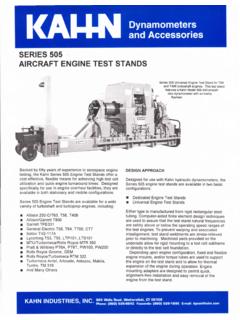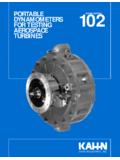Transcription of SCRAMJET COMBUSTOR DEVELOPMENT - The Combustion …
1 SCRAMJET COMBUSTOR DEVELOPMENT Dr. Satish Kumar & Team* Head, Hypersonic Propulsion Division & Dy. Project Director, HSTDV,DRDL, Hyderabad 1. Introduction: An airframe integrated SCRAMJET propelled vehicle has advantages for application to several missions. In its simplest form, such a vehicle will combine the features of quick reaction, low vulnerability to counter attack and better propulsion efficiency. The Supersonic Combustion Ramjet ( SCRAMJET ) engine has been recognized as the most promising air breathing propulsion system for the hypersonic flight (Mach number above 5). In recent years, the research and DEVELOPMENT of SCRAMJET engine has promoted the study of Combustion in supersonic flows.
2 Extensive research is being carried out over the world for realizing the SCRAMJET technology with hydrogen fuel with significant attention focused on new generations of space launchers and global fast-reaction reconnaissance missions. However, application for the SCRAMJET concept using high heat sink and hydrogen fuels offers significantly enhanced mission potential for future military tactical missiles. SCRAMJET being an air-breathing engine , the performance of the missile system based on the SCRAMJET propulsion is envisaged to enhance the payload weight and missile range. Supersonic Combustion ramjet engine for an air-breathing propulsion system has been realized and demonstrated by USA on ground and in flight.
3 X-43 vehicle used hydrogen fuel. Hydrocarbon fuel SCRAMJET engine is still under study and research. Mixing, ignition and flame holding in COMBUSTOR , ground test facilities and numerical simulation of SCRAMJET engine are the critical challenges in the DEVELOPMENT of SCRAMJET engine . ??Dr. Charyulu, Moorthy, C. Chandrasekhar SCRAMJET engine - Technological challenges a) Mixing, Ignition and flame holding in a SCRAMJET COMBUSTOR Among the three critical components of the SCRAMJET engine , the COMBUSTOR presents the most formidable problems. The complex phenomenon of supersonic Combustion involves turbulent mixing, shock interaction and heat release in supersonic flow.
4 The flow field within the COMBUSTOR of SCRAMJET engine is very complex and poses a considerable challenge in design and DEVELOPMENT of a supersonic COMBUSTOR with an optimized geometry. Such COMBUSTOR shall promote sufficient mixing of the fuel and air so that the desired chemical reaction and thus heat release can occur within the residence time of the fuel-air mixture. In order to accomplish this task, it requires a clear understanding of fuel injection processes and thorough knowledge of the processes governing supersonic mixing and Combustion as well as the factors, which affects the losses within the COMBUSTOR .
5 The designer shall keep in mind the following goals namely, i) Good and rapid fuel air mixing ii) Minimization of total pressure loss iii) High Combustion efficiency. b) Ground test facilities for testing of SCRAMJET engine . In order to carry out the experiments essentially required for the DEVELOPMENT of the SCRAMJET engine and to clearly understand various complex areas associated with it, there is a need of SCRAMJET test facility. Among the devices generally used to produce the test gas to simulate air entering the SCRAMJET COMBUSTOR are arc heater, ceramic storage heater and Combustion burners. The SCRAMJET ground test facilities are available in the mid Mach number range of 5 to 8.
6 There are no steady flow test facilities in higher Mach number range since achievement of total temperatures, pressure and low pressures at exit present enormous engineering challenges. Free piston shock tunnels enable test with duration of only milliseconds at higher Mach numbers. Conventional SCRAMJET facilities operate in the blow down mode since continuous operations implies very large power requirement for heating the air. c) Numerical simulation of SCRAMJET Flow field Ground tests and classical methods alone cannot give data with sufficient accuracy for design of hypersonic systems. Due to the closely integrated nature, component level testing will not be able to simulate accurately the complex flow field.
7 It is difficult to simulate Reynolds number, boundary layer transition in ground test facilities. Also, the quality of air is difficult to simulate in the test facilities. Therefore there is a need to estimate the performance in the flight based on the results of ground tests. This can be accomplished only through the use of mathematical modeling of the flow, which is to be solved to first reproduce the result of the ground test and then used for predicting the flight conditions. The primary unknown on a physical plane consists of modeling turbulence and its interaction with chemistry. The issues on the numerical front consist of evolving algorithms to solve the N S equations or their variants such that sharp gradient regions near the shocks are captured with numerical diffusion or overshoot.
8 The prediction of wall heat transfer rate is another task to be handled both on the modeling plane and numerical experiments. One of the advantages of the mathematical model is that once it stands validated it can be used to conduct several numerical experiments on exotic ideas like with respect to enhanced mixing components with much less expense as compared to experiments. The experimental effort is not eliminated but reduced and better focused. This is in fact the current day approach to the solution to the problems of high-speed flight. DEVELOPMENT and realization of SCRAMJET engine has been undertaken in USA, Russia, Japan, France, Germany and India individually as well as through joint cooperation.
9 The urgency of realizing a hypersonic air-breathing engine has been felt by many agencies for civilian and military applications. The DEVELOPMENT of the SCRAMJET engines poses considerable challenges and it demands multidisciplinary design, analysis, modeling, simulation and system optimization. The hardware realization and testing becomes equally complex and multidisciplinary. DRDL is working on a program called Hypersonic Technology Demonstrator Vehicle (HSTDV). Technological challenge for this vehicle is to demonstrate the SCRAMJET engine at a flight mach number of Number of ground-based experiments have been carried out to develop the SCRAMJET COMBUSTOR and associated test facilities also have been established in DRDL.
10 The details of test facility and tests carried out on the DEVELOPMENT of strut-based COMBUSTOR , Ramp-Cavity COMBUSTOR and barbotage injection of kerosene with hydrogen fuel as pilot are highlighted in the subsequent sections. 2. DEVELOPMENT OF THE KEROSENE FUELED STRUT BASED SCRAMJET COMBUSTOR TEST FACILITY: The setup consists of a Hydrogen burner as an on-line gas generator, an axi-symmetric convergent-divergent nozzle for accelerating the test gas to supersonic speed, a circular to rectangular transition duct. The supersonic COMBUSTOR has two parts; one constant area section with backward facing step with fuel injection strut and the second one is diverging area COMBUSTOR .





